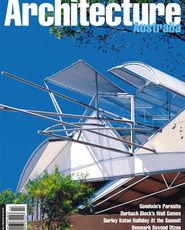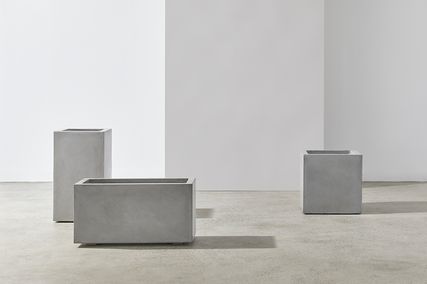|
The 40 UP: Australian Architecture’s Next Generation exhibition is the kind of event which tends to happen at the peak of a building boom, when sponsors (in this case, Lend Lease’s Stephen McMillan and Ross Bonthorne) are inclined to be generous to youngsters striving to move from kitchen extensions into the Venn circles of high-powered city development. This show, conceived mainly to inform the public rather than the profession, presents recent buildings and interiors from 40 small studios with directors aged 25 to 45. They were chosen from a list of 80 offices which have all built notable concepts. Almost all of the exhibitors are based in the east coast cities where design is most strongly supported. So I push a bias that the best architecture comes from Melbourne and Sydney, and a few firms in south Queensland. However, many of my city selections, the dearth of architects from communities like Ayers Rock and Darwin, and my decision not to include working drawings have disappointed this year’s RAIA Gold Medallist, Richard Leplastrier. After assessing the envelopes of slides, he decided not to endorse the show by writing a catalogue foreword.  Geoform house at Lillipilli (Paul Gosney). What does 40 UP reveal about Australian architecture at the end of the 20th century? There’s no single theme. The profession clearly has left behind that modernist notion of universal aesthetics (in retrospect, a banal anticipation of the global age). Yet certain tendencies can be detected and compared. Most of the current directions arise more from the vagaries of personalities and cultural coteries than Norberg-Schultzian lore about climate, site and spirit of place. There’s ample evidence in 40 UP to suggest that competing styles can jostle on the ground of genius loci. This show also demonstrates that the impulses of most architects—even those labelled ‘innovative’—are more nostalgic than futuristic. The dilemma is to choose which historical and foreign precedents to interpret—and what values to accept and reject from current local culture. Consider Frank Macchia, an arriviste in Noosa from Melbourne. He is busy building glamorous Mediterranean and Mexican courtyard houses which oppose the celebrated Sunshine Coast style of light sheds inspired by both early Queensland shacks and modernist strategies developed for colder climates. In Brisbane, Donovan Hill, Alice Hampson and Arkhe Field are continuing the Queensland tradition of light, weather-responsive buildings—but they are not resistant to masonry. Like some of their peers in Sydney and Melbourne—eg Peter Stutchbury and John Wardle—they are also triggered by Japanese and Melanesian architecture and the strategies of mid-century Italian sensualist Carlo Scarpa. |  TopLahz Nimmo house at Stanwell Park (Brett Boardman);aboveScreens in a Gary Marinko house at Margaret River (Jacqueline Stevenson). Among architects educated at the Sydney schools, there’s prevalent concern with restrained rationality and legible tectonics— along with myopic disdain for romantic quests, as pursued by two Italians, Luigi Rosselli and Renato D’Ettorre (along with Noosa’s Macchia). Practising ‘bush brutalism’ (gutsy, romantic, crafted with rugged materials) are Peter Stutchbury, Drew Heath and David Langston-Jones (the latter with houses in Cairns). Refining the early modernists’ cubic concepts—and sometimes producing what Leon van Schaik calls ‘frames for living’—are Geoform, Stanic Harding, Engelen Moore, Marsh Cashman + Curve 9 and (using looser geometries) Durbach Block and Stephen Varady. Their interstate counterparts are Shelley Penn, Sean Godsell and Chris Connell in Melbourne and Leigh Woolley with Craig Rosevear in Hobart. A third NSW coterie is harder to categorise: its members use more varied palettes and are more flexible and unpredictable. This group includes Virginia Kerridge and Robert Weir, Rosselli and D’Ettorre, Bourne & Blue of Newcastle, John Cockings, Lahz Nimmo, Sam Marshall and, in Merimbula, Clinton Murray. Over in Perth, Gary Marinko has a spiritual connection—as do Adelaide’s Nick Tridente and Phillips Pilkington. In Melbourne, the modernists and the mad-hatters remain in contest. The latter caste is looking ever-more sane and relevant as we convert from industrial technologies to digital production and information.  Frank Macchia house at Noosa (Yanni van Zijl). In the expressionistic group, delivering architecture which represents different creative impulses at various levels of intensity, are Grant Amon, Shane Williams, Six Degrees, McBride Charles Ryan, Chris de Campo and Elenberg Fraser. The progressive modernists include Connell and Penn, Kerstin Thompson, John Wardle, Geoff Crosby, Peter Maddison and Sean Godsell. Brearley Middleton have their feet in both camps as modernists who explore edgy ideas with artists. Davina Jackson is AA’s editor and the curator of 40 UP, which opened at Sydney’s Darling Park on February 18. It also goes to Interior Designex in Melbourne mid-May. |
















